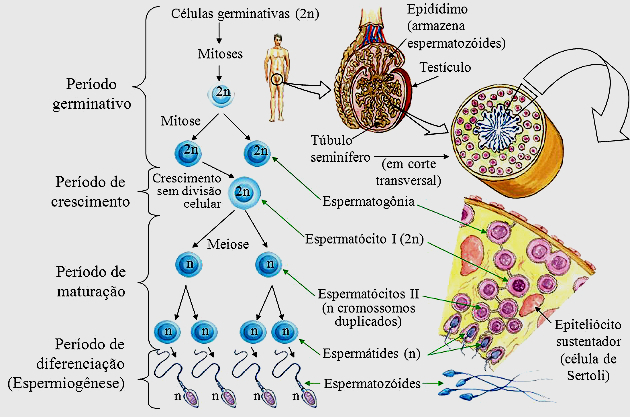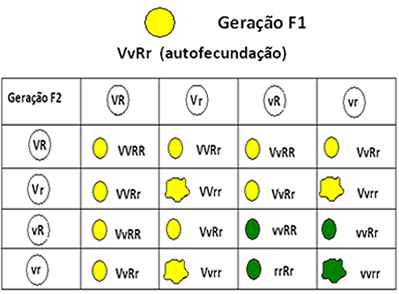Spermatogenesis is the process by which male gametes, the spermatozoa, are formed and that occurs in the seminiferous tubes of the testes.
Because the testes are located outside the abdominal cavity, in the scrotum, they have a temperature of up to 1°C lower than body temperature. This guarantees the ideal temperature for the formation of sperm.
This process begins at puberty and continues throughout a man's life.
Testicles

Each testis is made up of the seminiferous tubules, U-shaped, thin and curled. They are formed by seminiferous epithelium, tissue specialized in the production of sperm.
After production, sperm migrate and are stored in the epididymis, where they complete their maturation.
Stages of Spermatogenesis
Spermatogenesis comprises four successive phases:

1. Proliferative or Multiplication Phase
The start of spermatogenesis occurs through spermatogonia, diploid cells (2n = 46 pairs of chromosomes). They multiply by mitosis in the wall of the seminiferous tubules and become abundant.
Sertoli cells, located around the seminiferous tubules, are responsible for the nutrition and support of spermatogonia.
The multiplication phase becomes more intense after puberty and lasts for a man's entire life.
2. Growth stage
During the growth phase, spermatogonia grow, that is, they increase the volume of their cytoplasm. From there, they divide by mitosis, originating the primary spermatocytes (spermatocytes I).
Primary spermatocytes are also diploid (2n).
Also read about the gametes.
3. Maturation Phase
In the maturation phase, the primary spermatocytes undergo the first division by meiosis, giving rise to 2 haploid daughter cells (n = 23 pairs of chromosomes), called secondary spermatocytes (spermatocyte II).
As they underwent meiosis, the secondary spermatocytes are haploid, however, with chromosomes still duplicated.
Only after the second meiotic division, the two secondary spermatocytes give rise to four haploid spermatids (n).
Learn more about gametogenesis.
4. spermiogenesis

The final stage of spermatogenesis consists of the transformation of spermatids into spermatozoa, a differentiated process called spermiogenesis and divided into four phases:
- Golgi phase: start of acrosome development (from Golgi complex granules) and sperm tail formation.
- Hood phase: the acrosome forms a cap over the anterior portion of the nucleus and starts the projection of the flagellum.
- Acrosome Phase: acrosome redirects and covers about 2/3 of the core.
- Maturation Phase: condensation of the nucleus and disposal of unneeded portions of the cytoplasm. Mitochondria organize themselves at the base of the flagellum, ensuring the energy needed to move the flagellum.
The entire spermatogenesis process can take from 64 to 74 days, divided as follows: 16 days in the period of spermatogonial mitosis; 24 days at first meiosis; 8h in the second meiosis, and about 24 days in spermiogenesis.
sperm
At the end of spermatogenesis, the product is the sperm, the reproductive cell of men. It differs in that it is a mobile cell, able to move around until it finds a secondary female oocyte, which will ensure the fertilization.
The sperm's tail is divided into three parts: middle piece, main piece and end piece. This structure allows the locomotion of the male sexual gamete to the egg.
The sperm also has the acrosome, a more rigid structure that represents the head of the sperm. It has enzymes that facilitate penetration into the egg, in addition to containing genetic material for the transmission of hereditary characteristics of paternal origin.
The testes produce about 200 million sperm a day.

